|
|
|
Sort Order |
|
|
|
Items / Page
|
|
|
|
|
|
|
| Srl | Item |
| 1 |
ID:
078233


|
|
|
|
|
| Publication |
2007.
|
| Summary/Abstract |
There is a large literature on the relationship between economic growth and defense spending, but its findings are often contradictory and inconclusive. These results may be partly due to non-linear growth effects of military expenditure and incorrect model specifications. The literature also appears lacking an empirical analysis of interaction between military spending and the arms trade and the impact of these two on growth. This paper investigates this non-linear interaction in the context of the Solow and Barro growth models recommended by Dunne et al.1 (2005). Using fixed effects, random effects, and Arellano-Bond GMM estimators, I examine the growth effects of military expenditure, arms trade, and their interaction in a balanced panel of 28 countries during 1965-2000. The augmented Solow growth model specified in Dunne et al. (2005) yields more robust estimates than the reformulated Barro model. I find that higher military spending and net arms exports separately lead to lower economic growth, but higher military spending is less detrimental to growth when a country is a net arms exporter.
|
|
|
|
|
|
|
|
|
|
|
|
|
|
|
|
| 2 |
ID:
086260
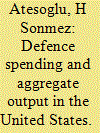

|
|
|
|
|
| Publication |
2009.
|
| Summary/Abstract |
In this article the effect of defense spending on aggregate output is discussed. Recent publications in this area are reviewed and new additional evidence is provided. The findings presented in this paper are supportive of the positive effect of defense spending. However, in light of the contrary evidence presented in other papers, empirical evidence taken as a whole, suggests that a definitive conclusion about the effect of defense spending at this time should be avoided.
|
|
|
|
|
|
|
|
|
|
|
|
|
|
|
|
| 3 |
ID:
087003
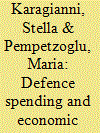

|
|
|
|
|
| Publication |
2009.
|
| Summary/Abstract |
This paper uses linear and non-linear Granger causality methods to determine the causal relationship between defense spending and economic growth in Turkey for the period 1949-2004. The innovative feature of this paper is that it provides evidence regarding the nonlinear causal dependence between military spending and economic growth in Turkey. The empirical results contribute to the empirical literature by indicating support for both linear and non-linear causality between military expenditures and economic development and they may prove useful in theoretical and empirical research by regulators and policy makers.
|
|
|
|
|
|
|
|
|
|
|
|
|
|
|
|
| 4 |
ID:
134029
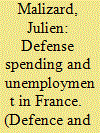

|
|
|
|
|
| Publication |
2014.
|
| Summary/Abstract |
France has received little attention in the literature of defense economics, despite some outstanding features of the country's situation. This study attempts to partially fill this gap with new empirical evidence which evaluates the influence of military expenditure on the unemployment rate between 1975 and 2008. Our estimation is based on the ARDL approach to cointegration. The results reveal that both defense and non-defense spending exert a negative influence on unemployment but that defense spending has a higher negative impact.
|
|
|
|
|
|
|
|
|
|
|
|
|
|
|
|
| 5 |
ID:
187360


|
|
|
|
|
| Summary/Abstract |
This paper examines the main determinants of French defense spending over the period 1958–2017. To estimate the determinants of defense spending, the demand defense literature considers both economic and strategic factors such as conflicts, threats, and alliances. Our approach is original because we focus on strategic factors, including proxies for an alliance’s membership and external threats. In addition, we include transnational terrorism as a proxy for internal threats. We find that defense spending is positively related to the gross domestic product, North Atlantic Treaty Organization membership, military operations abroad, and external threats and negatively linked to the population as a proxy to public service needs. These results are robust to changes in specifications and shifts in defense policy observed after 1991. This contribution underlines that the fundamental determinants of defense policy in France are economic conditions.
|
|
|
|
|
|
|
|
|
|
|
|
|
|
|
|
| 6 |
ID:
127669
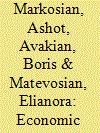

|
|
|
|
|
| Publication |
2013.
|
| Summary/Abstract |
This article takes a look at the current state and dynamics of Armenia's economy over the past few years; the authors have studied several budget expenditure items, and also carried out a comparative analysis of Armenia's external trade indices with the countries of the region.
Involvement in any conflict, particularly one that is unresolved, has an impact on the country's economy and makes it unattractive to investors, who do not like vagueness and avoid risks; commerce strives to minimize transactional outlays, while closed borders lead to enclave development. This is precisely how Armenia's economy has been developing over the past two decades.
This situation is making the country's economy dependent on particular players, different factors, and so on, and is leading to monopolization of its main branches and underdevelopment of sectors that in other conditions could become a catalyst for economic progress.
An analysis of the economic growth trends in the Republic of Armenia (RA) shows that this growth is still having little influence on the standard of living of the country's population, since government budget expenditures are mainly oriented toward defense. At the same time, the main source of personal monetary income comes from private remittances.
Investment flows and Armenia's reciprocal trade with neighboring countries are going against the overall economic integration trends. This is causing countries that are already in a state of conflict to move increasingly away from each other.
The authors of this article think that economic cooperation among all the countries of the Southern Caucasus should become an alternative to the continuing conflict.
|
|
|
|
|
|
|
|
|
|
|
|
|
|
|
|
| 7 |
ID:
095043


|
|
|
|
|
| Publication |
2010.
|
| Summary/Abstract |
Empirical evidence on the effect of defense spending on US output is at best mixed. Against this backdrop, this paper assesses the impact of a positive defense spending shock on the growth rate of real GNP using a Factor Augmented Vector Autoregressive (FAVAR) model estimated with 116 variables spanning the quarterly period of 1976:01 to 2005:02. Overall, the results show that a positive shock to the growth rate of the real defense spending translates to a positive short-run effect on the growth rate of real GNP lasting up to ten quarters, but the effect is significant only for two quarters. Beyond the tenth quarter, the effect becomes negative and shows signs of slow reversal at around the 17th quarter. Our results tend to indicate that the mixed empirical evidence, based on small-scale Vector Autoregressive (VAR) and Vector Error Correction (VEC) models, could be a result of a small information set not capturing the true theoretical relationships between the two variables of interest.
|
|
|
|
|
|
|
|
|
|
|
|
|
|
|
|
| 8 |
ID:
185350
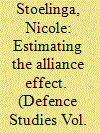

|
|
|
|
|
| Summary/Abstract |
In a time of rising threat, recurring discussions about burden sharing within NATO and twenty years after the start of the “war on terrorism,” I explore a novel idea in the field of alliance and defense spending: the effect of alliance membership on defense spending in response to a threat. Instead of estimating the determinants of defense spending or burden sharing among members, this paper focuses on two types of states (small and large) and how alliance membership shapes their response to threat. Using the synthetic control method, I create a comparison unit for each type consisting of a weighted average of non-NATO, European countries. 2001 is considered as the starting year of widespread threat, caused by a sudden increase in transnational terrorism. This way, I can estimate the “alliance effect.” I find that both types of states have stronger (positive) response to threat as NATO members, compared to if they would not have been part of the alliance.
|
|
|
|
|
|
|
|
|
|
|
|
|
|
|
|
| 9 |
ID:
095047


|
|
|
|
|
| Publication |
2010.
|
| Summary/Abstract |
The present article aims at investigating the causal relationship between defense spending and terrorism in Turkey using the Autoregressive Distributed Lag (ARDL) bounds testing procedure and Granger-causality analysis. The findings reveal that there exists a unidirectional causality running form terrorist attacks to defense spending as expected, but not vice versa. In the light of this finding it can be inferred that military anti-terrorism measures alone are not sufficient to prevent terrorism.
|
|
|
|
|
|
|
|
|
|
|
|
|
|
|
|
| 10 |
ID:
113826


|
|
|
|
|
| Publication |
2012.
|
| Summary/Abstract |
Gender is now recognized as an important dividing line in American political life, and scholars have accumulated evidence that national security issues are an important reason for gender differences in policy preferences. We therefore expect that the dynamics of support for defense spending among men and women will differ. In contrast, several scholars have shown that population subgroups exhibit a "parallel" dynamic in which the evolution of their preferences over time is very similar, despite differences in the average level of support. Unfortunately, there is little time series evidence on gendered reactions to policy, including defense spending, that would allow one to arbitrate between these competing perspectives. In this research note, we assemble a time series of support for defense spending among men and women and model the determinants of that support for the period 1967-2007. We find that women are on average less supportive of defense spending than are men. However, we also find that the over time variation of support for defense spending among men and women is very similar-each is conditioned principally by the past year's change in defense spending and occasionally by war casualties and a trade-off between defense and civilian spending.
|
|
|
|
|
|
|
|
|
|
|
|
|
|
|
|
| 11 |
ID:
176440


|
|
|
| 12 |
ID:
165884


|
|
|
|
|
| Summary/Abstract |
The popular notion of a trade-off between social and defense spending—or guns versus butter—appears often in elite discourse, popular media, and empirical studies of budgetary politics. Yet, there are good reasons to suspect that the public’s preferences for these types of spending do not reflect that trade-off. I develop a theory that whether social and defense spending preferences are competing or complementary depends on if the respondent views the government as an important contributor to job creation. Using data from fifty-nine surveys in twenty-seven countries from 1985 to 2008, I show that favoring government-financed job creation makes a respondent much more likely to view social and defense spending as complementary. Indeed, aside from the anomalous case of the United States, preferences are consistent with guns yield butter instead of guns versus butter. This theory has important implications for the thermostatic model of policy responsiveness and theories of budgetary politics.
|
|
|
|
|
|
|
|
|
|
|
|
|
|
|
|
| 13 |
ID:
133159
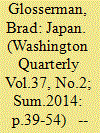

|
|
|
|
|
| Publication |
2014.
|
| Summary/Abstract |
Japanese Prime Minister Abe Shinzo's goal is simple: end all doubts about his country's status as a first-tier nation. From inventing the Abenomics program, intended to spark an economic rejuvenation, to creating new security institutions as well as articulating new defense policies and doctrines, the Abe administration has focused on creating the conditions which would allow Japan to more forcefully assert and defend its national interests. Over a year into his first term, signs are good: the economy has rebounded; defense spending is up; Tokyo has pursued a new, aggressive diplomacy re-establishing its bona fides in the region and beyond; and the Japanese seem to be more optimistic about their prospects.
|
|
|
|
|
|
|
|
|
|
|
|
|
|
|
|
| 14 |
ID:
137934


|
|
|
|
|
| Summary/Abstract |
This study revisits the long run and dynamic causal linkages between defense spending and economic growth in 15 selected European countries for the period 1988–2010 by utilizing recent developments in non-stationary panel data analysis. To this end, the series properties of per capita defense spending, per capita real capital stocks, and per capita real GDP are investigated by the panel unit root tests with and without breaks that support evidence on unit root. The panel cointegration tests with and without breaks are also subsequently employed to investigate whether there exists a long-run equilibrium relationship between these three variables. Finally, our causality analysis from panel vector error-correction model suggests that there is a feedback relation between real capital stock and real GDP in both short and long run, a one-way Granger causality running from real GDP to defense spending in both short and long run, and defense spending only Granger causes real capital stock in the long run.
|
|
|
|
|
|
|
|
|
|
|
|
|
|
|
|
| 15 |
ID:
150104
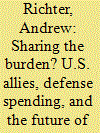

|
|
|
|
|
| Summary/Abstract |
Burden sharing has long been a goal of NATO. This article examines how three major alliance members—Canada, the UK, and Germany—are currently approaching defense issues, and the contributions they are making to the larger Western defense effort. It will reveal that Canada and Germany continue to spend little on defense, and seem broadly content to watch their military forces gradually weaken. On the contrary, however, the UK remains a major defense spender, although its fiscal situation poses a continuing challenge. For NATO to survive, the US must insist that it expects all alliance members to contribute more equitably.
|
|
|
|
|
|
|
|
|
|
|
|
|
|
|
|
| 16 |
ID:
171018
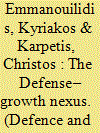

|
|
|
|
|
| Summary/Abstract |
A great part of the defense literature is focused on the interaction between military spending and economic activity. To investigate this interrelationship, researchers have applied a wide variety of methodologies with totally different assumptions and statistical properties. Until today, however, no detailed examination of the sensitivity of empirical results to the various statistical methods has been provided in the literature. The present paper attempts to fill this gap by providing, firstly, a review of the majority of the time series methodologies used in the defense–growth literature and, secondly, an econometric application using data of the U.S. economy over the period 1961–2015 in order to establish empirically the association between econometric procedures and empirical results. The empirical findings of the conducted analysis suggest that statistical methods can indeed become a significant source of variation in the investigation of the defense–growth nexus.
|
|
|
|
|
|
|
|
|
|
|
|
|
|
|
|
| 17 |
ID:
174606
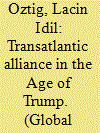

|
|
|
|
|
| Summary/Abstract |
NATO has successfully adjusted itself in the political and security environment of the post-Cold war era through enlargement, focusing on conflict prevention, crisis management and peacekeeping. Currently, the most important challenge to NATO comes from within. Under businessman-turned-U.S. President Donald J. Trump who focuses his attention on ‘making America great again’, the issue of burden sharing has dominated NATO’s agenda. President Trump has pressured European countries to increase their defense spending to meet the 2% of GDP defense spending objective of NATO. While the previous U.S. presidents also pressured European states with regard to burden sharing, President Trump’s rhetoric differs from his predecessors by associating American commitment to the Alliance directly to the defense spending of NATO’s European members. Importantly, this article shows that despite Trump’s skepticism of NATO and his rhetorical pressure on its member states regarding the issue of burden sharing, there is no change in the American approach to NATO at the policy level.
|
|
|
|
|
|
|
|
|
|
|
|
|
|
|
|
| 18 |
ID:
123089


|
|
|
|
|
| Publication |
2013.
|
| Summary/Abstract |
HEATHER ONDERCIN uses the framework of intersectionality to understand how gender, race, and region uniquely shape the attitudes of Southern white women. She ?nds that Southern white women hold distinctly different attitudes across a range of policy areas than do Southern men and non-Southerners.
|
|
|
|
|
|
|
|
|
|
|
|
|
|
|
|
| 19 |
ID:
085375
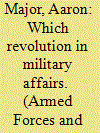

|
|
|
|
|
| Publication |
2009.
|
| Summary/Abstract |
Since the arrival of Secretary of Defense Rumsfeld, the discourse of American military strategy has been framed around a Revolution in Military Affairs (RMA). This article takes up the question of whether the RMA discourse represents a real strategic shift through an examination of the distribution of Defense Department spending on procurement across economic sectors and geographical space for the period 1990 to 2004. Detailed analysis of procurement data shows that the RMA builds on an earlier transformation in the United States' defense posture around the post-cold war disarmament rather than signal a new era for the military.
|
|
|
|
|
|
|
|
|
|
|
|
|
|
|
|
| 20 |
ID:
113753
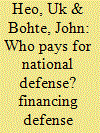

|
|
|
|
|
| Publication |
2012.
|
| Summary/Abstract |
Past studies on military expenditures in the United States have primarily focused on the extent to which guns versus butter trade-offs are prevalent without examining this relationship in the context of how other fiscal policy tools are used to pay for defense. Using annual data from 1947-2007, this study examines the relative importance of defense financing policy measures, such as guns versus butter trade-offs, tax increases, and deficit spending in paying for defense. The results show evidence of guns versus butter trade-off during the Reagan Era, but not during other periods. Both federal tax policy and deficit spending have played influential roles in funding defense spending during peacetime. This modeling strategy points to the importance of analyzing the effects of multiple fiscal policy tools when studying the forces that drive military spending in the United States since World War II.
|
|
|
|
|
|
|
|
|
|
|
|
|
|
|
|
|
|
|
|
|